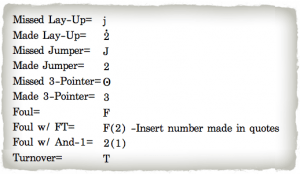 If you read my guide to charting a basketball game offensively then you know how strongly I believe in charting basketball games. To be honest, I don’t really see this vital tool being utilized at the high school level nearly enough. It really should be a part of every team’s game day rituals. While charting your offensive game is vital to see how efficiently your team is scoring points, charting your defense is equally as important.
If you read my guide to charting a basketball game offensively then you know how strongly I believe in charting basketball games. To be honest, I don’t really see this vital tool being utilized at the high school level nearly enough. It really should be a part of every team’s game day rituals. While charting your offensive game is vital to see how efficiently your team is scoring points, charting your defense is equally as important.
You chart the defensive game much like you would the offensive. You list your defenses that you have in the game plan. When your team runs a particular defense, you would assign a mark to the chart. For example, you may play man-to-man, 2-3 zone, and run a 1-2-2 full court press. You would have those listed and make the following notes on your chart at the appropriate time: If your team forces a missed layup you would mark a j. If you gave up a layup you would mark a 2 with a dot over it. If you forced a missed jumper, that is a J. If the offense made a jumper that gets a 2. If the opposing team misses a three point attempt, you’d mark an O with a dot in the middle. A made three pointer is a 3. If your team fouls, give an F. If your team fouls a shooter, mark it F and write the free throws made in quotations, F (2). If you foul and the shooter makes his attempt it gets a 2(1). If you force a turnover it would get a T.
All of these notes will tell you what defenses are working for you. They will tell you where you are giving up shots. If you are giving up a ton of layups, then that defense needs some tightening up. If you are running your full court trap and not getting any turnovers then you might need to switch things up. Charting the game defensively will help you decide what to run a crucial parts of the game.
I also like to chart how many points individual players have given up. I realize that any good defense is truly a team defense but I want some way to show what players are “getting after it” defensively. I simply list the players’ numbers and have a column for points given up. There’s a column for each quarter. If a player has let his man score 16 points in the first half then we can make a switch or get on him about stopping his man. If you are playing a zone defense you can still do this. I would just assign points to the player in the area or to the player who didn’t rotate, didn’t close out etc. For example, if you are hedging screens and nobody hedged on the screener, I would assign those points to the hedger not the guy guarding the ball. It is not a perfect system but it will show who is giving up points and allow you to make adjustments.
The last thing I would chart is consecutive stops. I chart three consecutive stops. If my team gets three stops in a row they would get a bubble filled in. Michigan State does this and calls three consecutive stops a “kill.” Three consecutive stops truly kill offensive momentum so the game makes sense. There is more stuff you can obviously think about charting. Someone has to chart rebounds whether it’s on the offensive or defensive chart. I would recommend charting second shots given up by your defense as well.
Well, I hope both of the charting articles gives some insight on charting basketball games. I know that if you do these things you will see an improvement in your game management and organization skills. Charting can give you an edge and it’s up to you to make the right adjustment from it!


